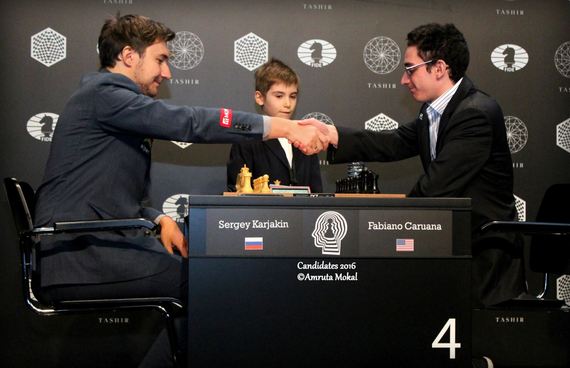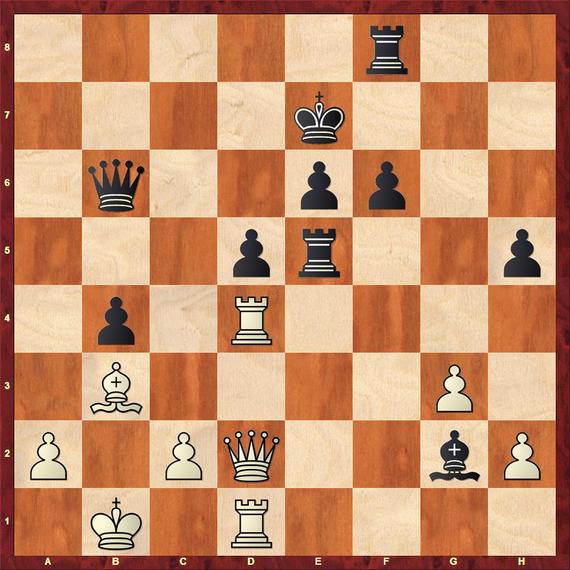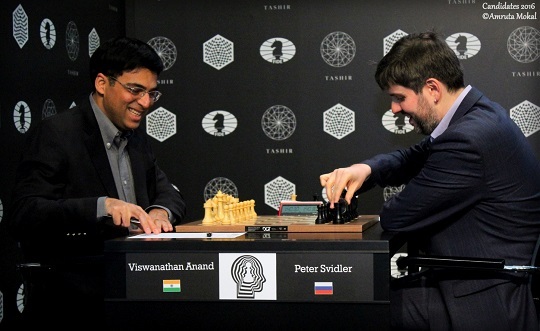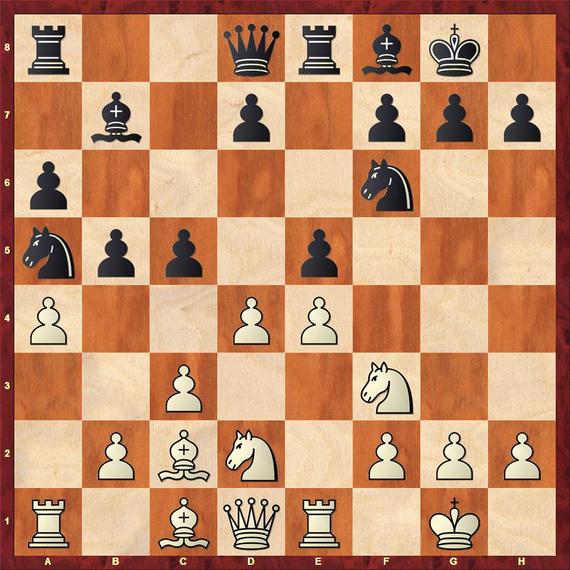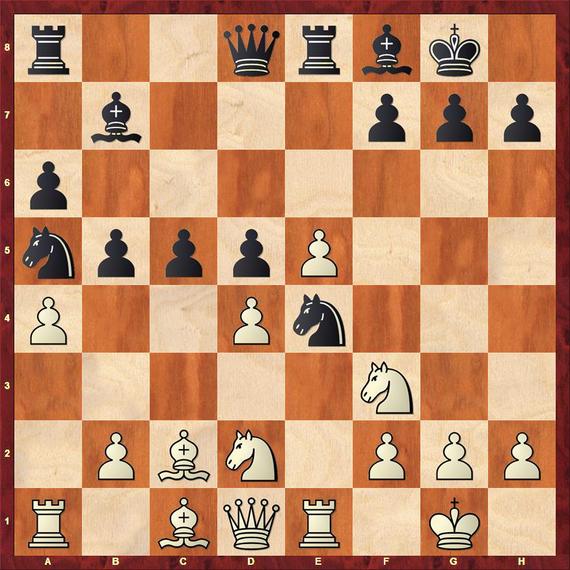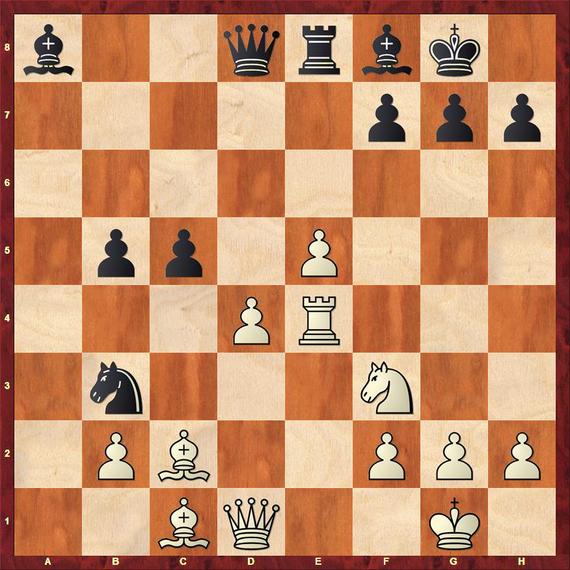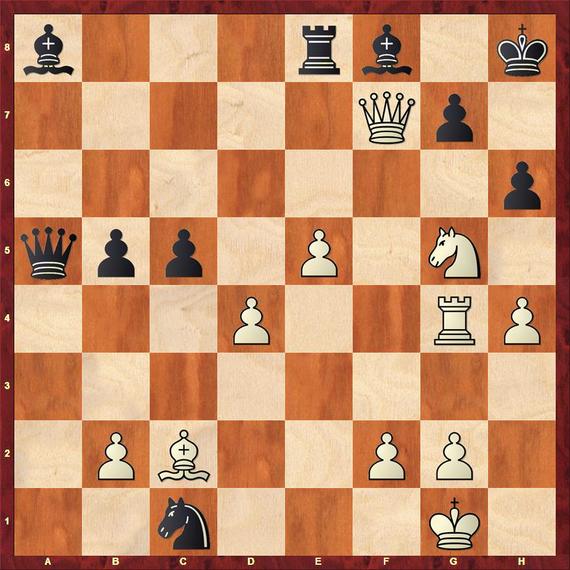On Monday in Moscow, Sergey Karjakin, 26, was trying to explain to journalists how he won the Candidates chess tournament, an eight-player double-round robin event to determine the challenger for the world champion Magnus Carlsen in the title match in November.
Karjakin's one point victory margin seems large, but the tournament's finishing stage was dramatic and exciting. Three players had a shot at first place. In the last two world championship matches, Carlsen defeated Vishy Anand. At the mature age of 46, the Indian grandmaster and the former world champion was still in the mix in Moscow.
Anand beat Karjakin in round 11 and with three rounds to go he joined Fabiano Caruana in the lead. In the next round Anand collapsed against the U.S. champion Hikaru Nakamura, but he played a huge role till the end. Meantime, Nakamura's countryman Caruana did not take advantage of having twice the white pieces, drew two games and allowed Karjakin to share the lead with him.
As fate would have it, Karjakin played Caruana in the last round. The winner of the game would face Carlsen, but what about a draw? By beating the seven-time Russian champion Peter Svidler in the last round, Anand would have joined the leaders at the top and the tiebreak would go to Caruana. Any other Anand's result would send Karjakin to the match with Carlsen. Pretty much, Caruana had to win.
Karjakin,Sergey - Caruana,Fabiano
The Candidates, Moscow 2016
It was a see-saw battle in the Rauzer Sicilian and the American player was able to keep enough material on the board to fight for the win. Eventually, the players reached a critical position after 36 moves.
36... Re4?
It is hard to blame Caruana for this move, but he is forcing Karjakin to make the winning combination. Instead, he could have given up the pawn 36... Bf3 37.Rxb4 Qc7 with a playable game.
37.Rxd5!
Without this rook sacrifice, White would be worse.
37... exd5 38.Qxd5
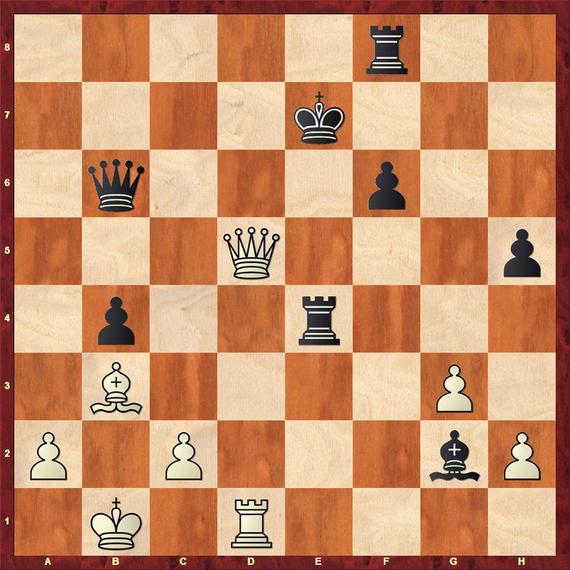
Threatening 39.Qd7 mate.
38... Qc7
Caruana did not have much time and his move loses by force. The only way to stay in the game was 38... Rd4 39.Qxd4 Qxd4 40.Rxd4 Rb8 White is a healthy pawn up and Black can't win.
39.Qf5! Rf7
After 39... Qc6 40.Qh7+ Ke8 41.Qxh5+ Ke7 42.Bd5+- wins.
40.Bxf7 Qe5
Playing into mate.
41.Rd7+ Kf8 42.Rd8+
White mates after 42... Kxf7 (42... Kg7 43.Qg6#; 42... Ke7 43.Qd7#) 43.Qh7+ Ke6 44.Qd7 mate.
Black resigned.
With the victory Karjakin avoided the tiebreak and became Carlsen's challenger. Caruana played a solid tournament, but Anand's results were all over the place. It was expected to be the other way around. The tournament's nestor fought with heart and was again close to qualifying. It is not easy to do at his age. Today, players are double-shifting: morning preparation date with computer and seconds, lasting two to four hours, is replaced by a seven-hour afternoon game. It requires stamina, it needs motivation. Anand was doing it for a quarter of century not only in the Candidates, but also in the world championships of every shape and form. Remarkable, really remarkable. And he often played beautiful chess. Here goes his entertaining miniature from Moscow:
Anand,Viswanathan - Svidler,Peter
The Candidates, Moscow 2016
1.e4 e5 2.Nf3 Nc6 3.Bb5 a6 4.Ba4 Nf6 5.0-0 Be7 6.Re1 b5 7.Bb3 0-0 8.a4 Bb7 9.d3 Re8 10.Nbd2 Bf8 11.c3 Na5 12.Bc2 c5 13.d4
In the main Chigorin Spanish set-up, Black would not have his pieces as ready for the fight in the middle of the board as in this position. He can act in the center, but how he does it makes a big difference.
13... exd4
Our forefathers, such as William Steinitz or Mikhail Chigorin, insisted on maintaining the pawn on e5 and probably would prefer 13... d6.
It seems that Black's life is easier after 13... cxd4 14.cxd4 and now:
A. 14... d5 should equalize as in the game Bruzon-Kaidanov, Mar del Plata 2012. It continued: 15.dxe5 (15.Nxe5 dxe4 16.Nxe4 Bxe4 17.Rxe4 Nxe4 18.Bxe4 Rxe5 19.Bxa8 Re8 20.Bf3 Qxd4=) 15... Nxe4 16.Qe2 (16.axb5 axb5 17.Nxe4 dxe4 18.Qxd8 Rexd8 19.Bxe4 Bxe4 20.Rxe4 Nc4 21.Rxa8 Rxa8=) 16...Rc8 17.Nxe4 dxe4 18.Bxe4 Bxe4 19.Qxe4 Rc4 20.Qf5 Qc8 21.Qxc8 Rexc8 22.Be3 Nb3 draw agreed.
B. 14... Qb6 a computer suggestion, attacking on the diagonal a7-g1, gives Black a good play.
14.cxd4 d5
A natural strike in the center connected with a pawn sacrifice. The computers suggest Black can survive after 14... cxd4 15.e5 Nd5, for example:
a) 16.Nb3 Bb4 (16... Nb4 17.Bxh7+! wins.) ;
b) 16.Nxd4 Nb4 17.Bb1 Qb6;
c) 16.Ne4 Nb4 17.Bb1 Qb6]
15.e5 Ne4
16.axb5!
Anand spent some time on this exchange. It turns out to be a novelty. Opening the a-file helps to escape with the queen-rook on move 19.
Svidler was following the game Shirov-Onischuk, Mallorca 2004, where Black accomplished a shocking knight leap after 16.Nxe4 dxe4 17.Rxe4 Nb3! Both white rooks are under attack and Shirov should have taken a draw by perpetual check with 18.Rh4, but he decided to fight and was outplayed: 18.Bg5 (18.Rh4!? Bxf3 19.Bxh7+ Kh8 20.Rh3! Bxd1 21.Bb1+ Kg8 22.Bh7+) 18... Be7 19.Bxe7 Qxe7 20.Rb1 Nxd4 21.Nxd4 Bxe4 22.Bxe4 Rad8 23.Bxh7+ Kf8 24.Qf3 Rxd4 25.Re1 Qg5 26.h4 Qd2 27.Rf1 Rxh4 and White resigned.
16... axb5 17.Nxe4 dxe4 18.Rxe4!
Sometimes the control of squares is preferable to hanging onto material. Anand gives up the exchange, but his light bishop dominates the entire board. Taking with the bishop gives Black control of the light squares after 18.Bxe4 Bxe4 19.Rxe4 Qd5 20.Re1 c4 with good compensation for the pawn.
18... Nb3
Now this leap is not as strong and actually leads to a lost position.
White would have a decisive advantage after 18... Bxe4 19.Bxe4 Ra6 20.Qd3 g6 (20... c4 21.Bxh7+ Kh8 22.Qf5+-) 21.Qxb5 Ra7 22.Bd2 Nc6 23.Rxa7 Nxa7 24.Qa4 Re7 25.d5+-.
19.Rxa8 Bxa8
20.Ng5!
A surprising turn, leading to a narrow winning path. Anand is outjumping his opponent and most of his pieces aim at the black king. The attacking wave is too strong.
20... Nxc1
There is no good defense for Black: 20... Bxe4 21.Bxe4 g6 22.Qxb3+-;
20... h6 21.Nxf7 Kxf7 22.Rf4+ Ke7 23.Bxb3+-;
20... Be7 21.Nxf7+-.
21.Qh5 h6
Giving up the queen does not help: 21... Qxg5 22.Qxg5 Bxe4 23.Qxc1 and White wins.
22.Qxf7+
More powerful than 22.Nxf7 Bxe4 23.Nxd8 g6 24.Qd1+-.
22... Kh8 23.Rg4!
Preparing to win immediately with 24.Qg6.
23... Qa5
The last trick, but Anand is alert. White wins after 23... Ne2+ 24.Kf1 Nxd4 25.Qg6+-.
24.h4!
A precise finish. Anand avoids 24.h3? Qe1+ 25.Kh2 Ne2 and Black escapes. White now wins after 24... Qe1+ 25.Kh2 Ne2 26.Nh3 The point! White protects the square g1. 26... Rd8 27.Qg6 Kg8 28.Qh7+ Kf7 29.e6+ Ke7 (29... Ke8 30.Qg6+ Ke7 31.dxc5+-) 30.Rxg7+ Bxg7 31.Qxg7+ Kxe6 (31... Kd6 32.e7 Re8 33.Qe5++-) 32.Qe5+ Kf7 (32... Kd7 33.dxc5! Qd2 34.Bf5+ Kc6 35.Be4+ Kd7 36.c6+ Kc8 37.Bf5++-) 33.Qc7+ and White wins.
Black resigned.
The Candidates have a rich history. Here are some interesting tidbits:
● In the first event in Budapest in 1950 Isaac Boleslavsky shared first place with David Bronstein. Boleslavsky was generous: not only did he narrowly lose the 14-game (!) play-off match, but later allowed Bronstein to marry his daughter.
● The best book on Candidates was written by Bronstein on Zurich 1953, a mammoth 15-player double-round robin lasting nearly two months. The winner, Vassily Smyslov, also won in 1956. He also holds the Candidates longevity record: his first appearance was in 1950 and his last in 1984, playing the final match against Garry Kasparov at the age of 63.
● Bobby Fischer was the youngest candidate ever at 16 in 1959 and he had the best overall score in 1971.
● When Mikhail Tal won the Candidates in 1959, the eight grandmasters played four times against each other - 28 games in all. It was the same in Curacao in 1962, where Fischer complained about the Soviets playing against him as a team. As a result, the Candidates changed from tournaments to matches.
● Boris Spassky already played in 1956, but had two incredible winning performances in 1965 and 1968. Viktor Korchnoi twice shined in 1977 and in 1980.
● Anatoly Karpov's winning run in 1974 brought him the world title in 1975 after Fischer declined to play him. Karpov also won the Candidates in 1987.
● Kasparov was at first disqualified in 1984 after he did not show up for his match with Korchnoi in Los Angeles, but the match was eventually replayed and Kasparov went all the way to the title match with Karpov.
● By winning the Candidates in Moscow, Karjakin will challenge Carlsen in the world championship match of two players born in the same year (1990).
Note that in the replay windows below you can click either on the arrows under the diagram or on the notation to follow the game.
Images by Amruta Mokal



